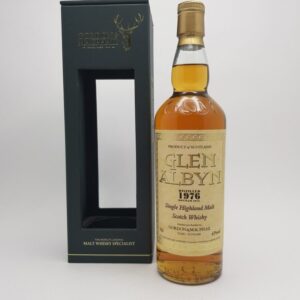Showing all 2 resultsSorted by popularity
Introduction to Glen Albyn
A Highland distillery with a fascinating legacy
Glen Albyn was a Scottish Highland distillery that once stood proudly on the shores of the Caledonian Canal near Inverness. Though now silent, this historic distillery contributed significantly to Scotland’s rich whisky heritage during its operational years. Located in the capital of the Highlands, Glen Albyn was part of the “Inverness Three” – a trio of neighboring distilleries that helped define the character of Highland malt whisky.
Its picturesque setting and connection to the waterways of Scotland made it not just a production facility but a landmark that connected the spirit of the Highlands to its natural environment.
Why we have a soft spot for Glen Albyn
At Vault of Spirits, we cherish distilleries like Glen Albyn that represent important chapters in whisky history. Though closed since 1983, Glen Albyn whiskies have become increasingly rare treasures that offer a taste of a bygone era in Scotch production.
We’re particularly fascinated by Glen Albyn’s unique profile that captured the essence of traditional Highland whisky making before the modernization wave transformed the industry. Each surviving bottle offers whisky enthusiasts a chance to experience a style of spirit that can never be replicated.
The History behind Glen Albyn
Origin and development
Glen Albyn was established in 1846 by James Sutherland, who converted an old brewery building for his new whisky-making venture. The distillery’s proximity to the Caledonian Canal provided excellent transportation links for both receiving raw materials and distributing the finished product.
Like many Scottish distilleries, Glen Albyn faced periods of closure throughout its history. It ceased production during World War I when it was requisitioned for use as a US Navy base to manufacture mines. After reopening in 1920, it was acquired by Distillers Company Limited (DCL) in 1972.
Sadly, Glen Albyn became a casualty of the infamous “whisky loch” crisis of the 1980s, when overproduction led to widespread distillery closures. The distillery was demolished in 1988, leaving only memories and increasingly rare bottles as its legacy.
The people behind the spirit
Throughout its operation, Glen Albyn benefited from the expertise of traditional Highland distillers who understood the delicate balance required to create a distinctive Highland malt. The later years under DCL’s management brought both stability and standardization to the production methods.
The workers who operated Glen Albyn’s stills were part of Inverness’s proud distilling community, and their craftsmanship lives on in the surviving expressions that occasionally appear at auctions and in specialist collections.
The Craft and Production
From raw materials to finished product
Glen Albyn utilized locally grown barley and the clear waters from the nearby Loch Ness watershed. The distillery employed traditional pot stills with a relatively short neck design, which contributed to a heavier, more robust spirit character.
The production methods at Glen Albyn remained largely traditional throughout its operation, with floor maltings being used until the modernizations of the mid-20th century. This connection to traditional methods gave Glen Albyn whisky its distinctive character that set it apart from its neighbors.
Maturation and aging
The spirit from Glen Albyn was typically matured in ex-bourbon casks, with some limited use of sherry casks for specialty releases. The Highland climate around Inverness, with its moderate temperature variations and coastal influence, contributed to a balanced maturation profile.
The warehouse location near the Caledonian Canal meant that the maturing spirit absorbed subtle maritime influences, which added complexity to the final product. Today, the few remaining casks of Glen Albyn are precious time capsules of a distillery style that can never be recreated.
Selected Products from Glen Albyn
Glen Albyn Official Bottlings – Increasingly rare treasures
Official bottlings from Glen Albyn are exceptionally rare, with only a handful of releases during its operation. These bottles are now highly sought after by collectors and enthusiasts eager to taste this lost Highland style. When found, they typically showcase notes of heather honey, orchard fruits, and a distinctive malty character with a hint of Highland peat.
Independent Bottlings – The guardians of legacy
Most available Glen Albyn expressions today come from independent bottlers who acquired casks after the distillery’s closure. These bottlings, often from specialists like Gordon & MacPhail or Signatory Vintage, offer varying ages and cask finishes.
The older expressions typically deliver a complex profile featuring dried fruits, gentle spices, oak tannins, and that unmistakable Highland character that made Glen Albyn special. Each bottle represents not just a dram, but a piece of whisky heritage.
Visiting the Distillery
A historical site
Unfortunately, as Glen Albyn was demolished in 1988, it is no longer possible to visit the distillery. The site where Glen Albyn once stood has been redeveloped, with retail outlets now occupying the location.
Whisky pilgrims can still visit Inverness to explore the rich distilling heritage of the area, including historical markers and local museums that document the significance of the “Inverness Three” distilleries in the region’s economic and cultural development.
Frequently Asked Questions
What was Glen Albyn?
Glen Albyn was a Highland Scotch whisky distillery located in Inverness, Scotland. Operating from 1846 until its closure in 1983, it produced a traditional Highland-style single malt whisky characterized by its robust body and subtle complexity. The distillery was part of the historical whisky landscape of Inverness alongside its sister distilleries Glen Mhor and Millburn.
Where was Glen Albyn located?
Glen Albyn was situated on the banks of the Caledonian Canal in Inverness, the capital of the Scottish Highlands. Its strategic location near this important waterway facilitated the transportation of materials and finished products, and the surrounding Highland environment influenced the character of its whisky.
What characterized Glen Albyn whisky?
Glen Albyn was known for producing a classically styled Highland malt with medium body and complexity. Typical flavor notes included heather honey, orchard fruits, malt, subtle spices, and occasionally a light touch of highland peat. The whiskies often featured a distinctive malty sweetness balanced with a dry finish that represented the traditional Highland style before regional characteristics became less pronounced in modern production.
Where can I buy whisky from Glen Albyn?
As Glen Albyn has been closed for nearly four decades, bottles are increasingly rare collectors’ items. At Vault of Spirits, we occasionally source rare bottlings from this lost distillery. These are usually independent bottlings from companies that had purchased casks before the distillery’s closure. Due to their rarity, Glen Albyn bottles represent not just exceptional whisky experiences but also valuable pieces of Scotch whisky history.

